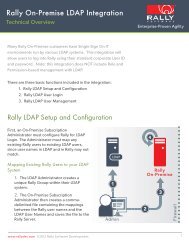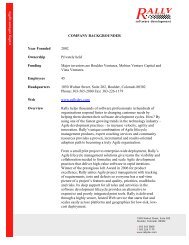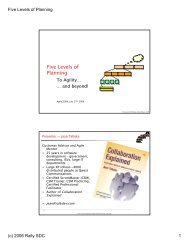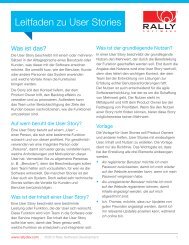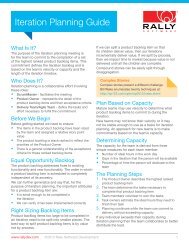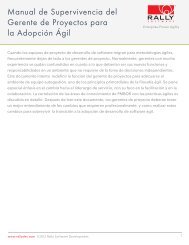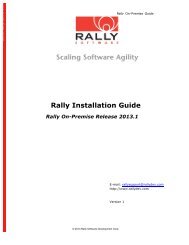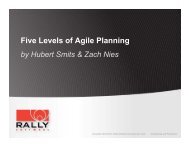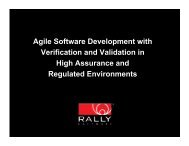A CIO's Playbook for Adopting the Scrum Method of ... - Rally Software
A CIO's Playbook for Adopting the Scrum Method of ... - Rally Software
A CIO's Playbook for Adopting the Scrum Method of ... - Rally Software
Create successful ePaper yourself
Turn your PDF publications into a flip-book with our unique Google optimized e-Paper software.
IntroductionThe pressures <strong>of</strong> a truly global economy cause today’s business to increasingly rely on <strong>the</strong>ir ability toproduce s<strong>of</strong>tware as a key competitive advantage. Whe<strong>the</strong>r it be s<strong>of</strong>tware <strong>for</strong> managing manufacturing andcustomer delivery processes or s<strong>of</strong>tware improving <strong>the</strong> efficiency <strong>of</strong> day to day activities, s<strong>of</strong>tware touchesvirtually every facet <strong>of</strong> today’s businesses.And yet <strong>for</strong> many organizations, s<strong>of</strong>tware development practices remain as <strong>the</strong>y were in <strong>the</strong> 1980s. Relianceon prescriptive, plan-based, waterfall methods is common despite mountains <strong>of</strong> evidence that <strong>the</strong>sepractices <strong>of</strong>ten fail to achieve real value delivery in a timely fashion, and so hamper our company’sresponsiveness to fast-changing customer requirements and market conditions. And it’s not getting easier.Today’s IT organizations must also effectively coordinate globally distributed s<strong>of</strong>tware development teamswhile re-factoring legacy applications into more flexible, service oriented architectures. Clearly, we need anew approach <strong>for</strong> managing and developing s<strong>of</strong>tware to remain competitive.Managing distributedorganizations andeffectively migrating toservice orientedarchitectures demanda new s<strong>of</strong>twaredevelopment approachkey to competitive success in <strong>the</strong> marketplace.To address <strong>the</strong>se challenges, a number <strong>of</strong> more agile and adaptive s<strong>of</strong>twaredevelopment techniques are being adopted which allow organizations to deliverhigher quality s<strong>of</strong>tware more quickly. <strong>Scrum</strong> is one such proven method that hasseen widespread adoption in many s<strong>of</strong>tware organizations. This whitepaperdescribes how a CIO or o<strong>the</strong>r executive manager can implement <strong>Scrum</strong> on anorganization-wide basis, including scaling across larger applications and teams <strong>of</strong>teams – <strong>the</strong> challenges he or she will face as well as <strong>the</strong> rewards – and provides aplaybook <strong>for</strong> adopting <strong>Scrum</strong> in enterprises where s<strong>of</strong>tware, and lots <strong>of</strong> it, is <strong>the</strong>This is a “playbook” <strong>of</strong> ideas about implementing <strong>Scrum</strong> within an enterprise. It is called a playbook ra<strong>the</strong>rthan a manual because each organization is unique. <strong>Scrum</strong>’s implementation within one enterprise will besignificantly different from its implementation in ano<strong>the</strong>r. The types <strong>of</strong> impediments, things that needchanging, <strong>the</strong> difficulty <strong>of</strong> change, and <strong>the</strong> people who will be doing <strong>the</strong> changing are different, so <strong>the</strong>timetables, <strong>the</strong> priorities, and <strong>the</strong> ef<strong>for</strong>t will be different as well.© 2005 <strong>Rally</strong> S<strong>of</strong>tware Development Corp., Ken Schwaber and <strong>Scrum</strong>Alliance 3



